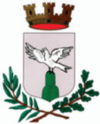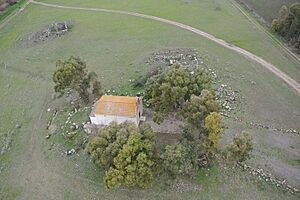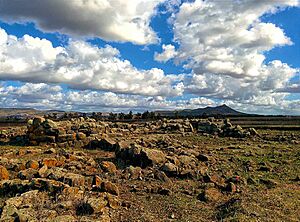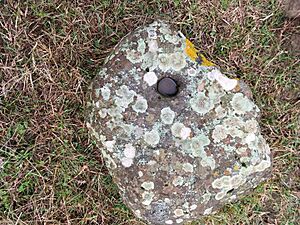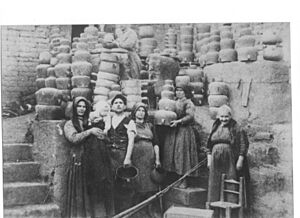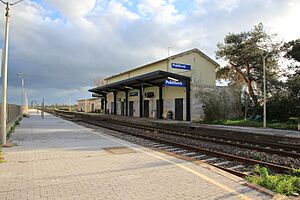Pabillonis facts for kids
Quick facts for kids
Pabillonis
Pabillonis
|
||
|---|---|---|
| Comune di Pabillonis | ||
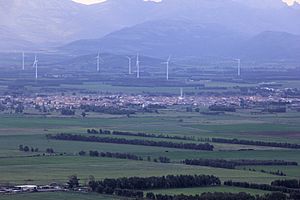 |
||
|
||
| Country | Italy | |
| Region | Sardinia | |
| Province | South Sardinia | |
| Frazioni | Foddi | |
| Area | ||
| • Total | 37.6 km2 (14.5 sq mi) | |
| Elevation | 42 m (138 ft) | |
| Population
(31 December 2006)
|
||
| • Total | 2,960 | |
| • Density | 78.72/km2 (203.9/sq mi) | |
| Demonym(s) | Pabillonesi | |
| Time zone | UTC+1 (CET) | |
| • Summer (DST) | UTC+2 (CEST) | |
| Postal code |
09030
|
|
| Dialing code | 070 | |
Pabillonis, also known as Pabillonis in the Sardinian language, is a small town (or comune) in the Province of South Sardinia in the Italian region of Sardinia. It's located about 50 kilometers (31 miles) northwest of Cagliari and 15 kilometers (9 miles) west of Sanluri.
Pabillonis shares its borders with several nearby towns like Gonnosfanadiga, Guspini, Mogoro, San Gavino Monreale, San Nicolò d'Arcidano, and Sardara.
Contents
About Pabillonis
Where is Pabillonis?
Pabillonis is found in the central-north part of the Campidano plain. It's close to where two rivers, Flumini Mannu and Flumini Bellu, meet. This area is mostly used for farming.
The town grew up around the church of San Giovanni. This church was once a country chapel and part of an old cemetery. Today, a town square stands where the cemetery used to be.
What does the name "Pabillonis" mean?
The name "Pabillonis" comes from the Latin word "Papilio-ionis". This word meant "Roman military camps" or "pavilions" set up in the area.
In the Sardinian language, the word changed over time to "Pabillone" or "Papigione". These terms can mean a woodshed or a shelter for animals. However, in the local dialect of Pabillonis, different words are used for animal shelters or wood storage.
Old documents from 1388, which talk about peace between Aragon and Arborea, mention the village as "Paviglionis" or "Pavillonis".
A Look at History
Early Times
People have lived in the Pabillonis area for a very long time. The first signs of humans date back to the Neolithic period (about 6,000 to 3,000 BC). Pieces of obsidian tools have been found, suggesting many villages once existed near water sources.
Later, the nuragic civilization left behind large stone towers called nuraghes. You can still find the remains of Nuraghe Santu Sciori, Nuraxi Fenu, and Nuraghe Domu'e Campu.
From Ancient Village to Modern Town
The original village of Pabillonis was a couple of kilometers from where it is today. Its ruins are near the old church of San Lussorio, by the Flumini Mannu river. An ancient Roman bridge called Su ponti de sa baronessa still stands there.
During the Middle Ages, Pabillonis was part of the Judicate of Arborea. The old village was destroyed by Saracen invaders. After this, it was rebuilt in its current location.
Later, in 1478, the town came under Aragonese rule. In 1584, the town was attacked by Moors. Many people were killed or taken as slaves, and the town was abandoned for a time.
Modern History
In 1934, during the fascist period, the marshy areas around the Flumini Mannu river were drained.
During World War II, in September 1943, the Pabillonis airfield was bombed by Allied Forces planes. This was one of the last war actions in Sardinia.
Places to Visit
Churches
Beata Vergine della Neve
The main church, Beata Vergine della Neve (Blessed Virgin of Snow), was built in the 1500s. It has a rectangular shape with three main sections inside. You can see old fresco paintings and a beautiful wooden tabernacle from the 1600s.
San Giovanni Battista
San Giovanni Battista (Saint John the Baptist) is the oldest church in Pabillonis, dating back to the 1100s. It was once part of the old cemetery. It's built in the Romanesque style and has a single main section and a bell tower with two bells.
Ancient Nuraghes
Near Pabillonis, you can find ancient nuraghes. These are large stone towers built by the Nuragic people long ago.
Santu Sciori
The Nuraghe Santu Sciori is located where the ancient village once stood. It has a strong base and towers, likely built around 1300 BC during the Middle Bronze Age. In the Middle Ages, it was used as a burial site. Parts of this nuraghe are now under a church built in the 1970s.
Nuraghe Fenu
The Nuraxi Fenu is about 3 kilometers (1.8 miles) from the town, near the train station. Digs started in 1996 found pieces of vases, lanterns, and Roman coins. This shows people used the site even in Roman times. This nuraghe is one of the largest poly-lobed complexes in Sardinia, also from the Middle Bronze Age (1300 BC).
Other Nuragic Sites
Other nuraghes like Nuraghe Dom'e Campu and Nuraghe De Sa Fronta once existed, but little or no trace remains today. There are also remains of the Giants' grave S'Ena and Zimini.
Archaeological Park
In 2018, the town created the Pabillonis Archaeological Park. This park aims to protect and share the history of all the ancient sites in the area.
Casa Museo
The Casa Museo (House Museum) is in the old part of Pabillonis. It's an old two-story house made of raw earth, beautifully restored and filled with antique items. It was given to the town by the Cherchi family. Today, it hosts exhibitions and cultural events. It also displays traditional clothes from Pabillonis.
Life in Pabillonis
Population and Languages
As of 2016, Pabillonis had about 2,721 residents. A small part of the population (about 2.59%) are from other countries.
The local language spoken in Pabillonis is a type of Sardinian language called western Campidanese.
Traditions and Festivals
Pabillonis has many important religious celebrations that also show off local traditions. Here are some of the main festivals:
- January 16: Saint Anthony Abbot (Saint Antoni 'e su fogu). This is a night party with a large bonfire called Su fogadoni.
- May 13: Madonna di Fátima.
- June 24: Saint John the Baptist. This celebrates the birth of Saint John the Baptist.
- August 5: Blessed Virgin of the Snow. This is the town's main patron saint festival.
- August 18: San Lussorio. This takes place at the country church of San Lussorio.
- August 29: Saint John the Baptist. This day remembers the death of Saint John the Baptist. People prepare Is carrus de s'àlinu (àbiu), which are ox-drawn carts and tractors decorated with alder branches.
- December 31: Su trigu cotu (cooked wheat). This is an old custom where people share cooked wheat as a good luck wish for the new year.
Culture and Crafts
Arts and Crafts
Pabillonis is very famous for its terracotta products, which are clay items like pots and pans. That's why the town is nicknamed Sa bidda de is pingiadas (the town of pans). People also make beautiful items from wicker, wood, and reeds. These crafts are shown off at special exhibitions every August.
Another unique craft is making raw earth bricks, called Ladins. These bricks are a mix of mud and straw. They give the town its special look, and efforts are being made to preserve and restore old houses made with them.
Pabillonis has been known for its terracotta for a very long time. The quality of its pots, pans, and other clay items was so good that they were sold all over Sardinia. The raw materials needed, like clay, were found right in the marshlands of Pabillonis. This made master potters, tile makers, and brick makers very important.
Tile Makers
Tile makers created terracotta tiles for roofs. This skill was passed down through families. In the 1830s, many craftsmen worked in this field. They needed a lot of wood to bake the tiles, sometimes more than the whole town used for other purposes!
Rules were put in place to manage how much wood was used and how tiles were sold. For example, tiles and bricks could not be sold outside Pabillonis for four days after they were made. This helped make sure local people could buy them first.
The Potters
Potters played a very important role in Pabillonis. They made everyday items like pots, pans, cups, and bowls from terracotta. The secrets of pottery were passed from father to son. The high quality of their products came from both the potters' skills and the excellent local clay.
The special clay, called "sa terra de stréxu," was found in the town's lands. This shows how long Pabillonis has been connected to making things from clay.
Making Clay Products
The clay was usually dug up in July. It was left to dry, then carried by women in baskets or by workers in carts. To make the clay ready, it was mixed with other types of earth: "sa terra de orbetzu" (which was soaked in water) and "sa terra de pistai" (a sandy earth that made the pots strong enough for fire).
These earths were mixed together by foot and hand until they were smooth. Then, the clay was shaped on a pottery wheel. A potter could make many pots in one day!
Pans were made upside down to make them thin. After shaping, they were left to dry. Handles were added the next day.
Cooking the Clay
The clay items were then cooked in an oven. Until the 1920s, ovens were open to the sky, so rain could stop cooking. Later, ovens were built with roofs. An oven could hold many pots. The pots were stacked carefully, one inside the other.
The first cooking lasted one day, with workers constantly feeding the fire to keep it hot. Lentisk wood or "cadriloi" flowers were often used as fuel.
Glazing and Second Cooking
To make the terracotta shiny, it was glazed. The glaze was a mix of red lead (from a mine) and silica (found in the local river). This mixture was poured over the items, and then they were cooked again. The second cooking lasted two days, using myrtle wood. This process made the pots strong and beautiful.
Raw Earth Bricks
Pabillonis also makes "làrdini" bricks. These are raw, unfired earth bricks made from a mix of clay, sand, water, and straw. This is an old tradition common in the Campidano plain.
List of Local Crafts
Here are some of the traditional craft products from Pabillonis:
- Terracotta:
* "tèulas" (tiles) * "tianus" (pans) * "pingiadas" (pots, pans) * "sciveddas" (smooth, polished terracotta basins)
- Raw Earth:
* "matoni in làrdini" (unfired earth bricks)
- Basketry:
* "scarteddus" (baskets) * "cibirus" (sieves) * "crobis" (large baskets)
Getting Around
Roads
Pabillonis is connected to nearby towns by several provincial roads, including SP 63, 64, 69, and 72.
Railways
Pabillonis has had a railway station since 1872. However, since June 2014, passenger trains no longer stop there. People from Pabillonis now use the train station in San Gavino.
Images for kids
See also
 In Spanish: Pabillonis para niños
In Spanish: Pabillonis para niños


